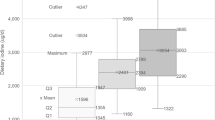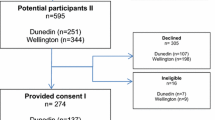Abstract
Objective
Globalisation has extended to the kitchen and the Asian cuisine has gained international popularity with sushi and seaweed now being widespread. We explored the possible acute adverse effects of an iodine load from a single sushi-and-seaweed meal as seaweed iodine may induce thyroid dysfunction.
Methods
Nine euthyroid participants were randomized into three groups: Halibut maki roll with either (A) newly harvested Greenlandic seaweed salad, (B) no seaweed salad on the side, or (C) Japanese seaweed salad purchased at a local store. We collected spot urine and blood samples daily for a week for measurement of iodine and creatinine in urine, thyroid stimulating hormone (TSH), and estimated-free T4 (fT4) in serum.
Results
All participants ingested the full meal and the drop-out was nil. No adverse effects were reported. Pre-meal urinary iodine excretion (UIE) was 75 µg/g. UIE rose (p < 0.001) by 385%, 59% and 43% for groups A, B, and C, peaked in the 6-h spot urine sample at 393, 120, and 109 µg/g, and was down to pre-meal values by day 2. Serum TSH rose (p = 0.012) 150% on day 2 and was down to pre-meal values by day 3. Serum fT4 remained at the same level. No adverse reactions were reported.
Conclusion
A sushi meal increased urinary iodine excretion by 40 µg/g, or 400 µg/g if a newly harvested seaweed salad was added. An ensuing rise in serum TSH was brief, and a single sushi meal with seaweed salad did not cause any adverse events.



Similar content being viewed by others
References
Teas J, Pino S, Critchley A, Bravermann L (2004) Variability of iodine content in common commercially available edible seaweeds. Thyroid 14:836–841
Aquaron R, Delange F, Marchal P, Lognoné V, Ninane L (2002) Bioavailability of seaweed iodine in human beings. Cell Mol Biol 48:563–569
Andersen S, Noahsen P, Rex KF, Florian-Sørensen HC, Mulvad G (2019) Iodine in edible seaweed, its absorption, dietary use and relation to iodine nutrition in Arctic people. J Med Food 22:421–426
Hetzel BS, Dunn JT (1989) The iodine deficiency disorders: their nature and prevention. Ann Rev Nutr 9:21–38
Laurberg P, Bülow Pedersen I, Knudsen N, Ovesen L, Andersen S (2001) Environmental iodine intake affects the type of nonmalignant thyroid disease. Thyroid 11:457–469
Konno N, Makita H, Yuri K, Ilzuka N, Kawasaki K (1994) Association between dietary iodine intake and prevalence of subclinical hypothyroidism in coastal regions of Japan. J Clin Endocrinol Metab 78:393–397
Zava TT, Zava DT (2011) Assessment of Japanese iodine intake based on seaweed consumption in Japan: a literature-based analysis. Thyroid Res 4:14
Teng X, Shan Z, Chen Y et al (2011) More than adequate iodine intake may increase subclinical hypothyroidism and autoimmune thyroiditis: a cross-sectional study based on two Chinese communities with different iodine intake levels. Eur J Endocrinol 146:943–950
Wolff J, Chaikoff IL (1948) Plasma inorganic iodide as a homeostatic regulator of thyroid function. J Biol Chem 174:555–564
Teas J, Braverman LE, Kurzer MS, Pino S, Hurley TG, Herbert JR (2007) Seaweed and soy: companion foods in Asian Cuisine and their effects on thyroid function in American women. J Med Food 10:90–100
Sang Z, Wang PP, Yao Z, Shen J, Halfyard B, Tan L, Zhao N, Wu Y, Gao S, Tan J, Liu J, Chen Z, Zhang W (2012) Exploration of the safe upper limit of iodine intake in euthyroid Chinese adults: a randomized double-blind trial. Am J Clin Nutr 95:367–373
Andersen S, Hvingel B, Laurberg P (2002) Iodine content of traditional Greenlandic food items and tap water in East and West Greenland. Int J Circumpolar Health 61:332–340
Atanassova V, Reich F, Klein G (2008) Microbiological quality of sushi from sushi bars and retailers. J Food Prot 71:860–864
Clark CD, Basset B, Burge MR (2003) Effects of kelp supplementation on thyroid function in euthyroid subjects. Endocr Pract 9:363–369
Miyai K, Tokushige T, Kondo M (2008) Suppression of thyroid function during ingestion of seaweed “kombu” (Laminaria japonica) in normal Japanese adults. Endocr J 55:1103–1108
Wilson B, van Zyl A (1967) The estimation of iodine in thyroidal amino acids by alkaline ashing. S Afr J Med Sci 32:70–82
Andersen S, Hvingel B, Kleinschmidt K, Jørgensen T, Laurberg P (2005) Changes in iodine excretion in 50–69-y-old denizens of an Arctic society in transition and iodine as a biomarker of the frequency of consumption of traditional Inuit foods. Am J Clin Nutr 81:656–663
Bartels H, Bohmer M, Heierli C (1972) Serum creatinine determination without protein precipitation. Clin Chim Acta 37:193–197
Andersen S, Bruun NH, Pedersen KM, Laurberg P (2003) Biologic variation is important for interpretation of thyroid function tests. Thyroid 13:1069–1078
Andersen S, Pedersen KM, Bruun NH, Laurberg P (2002) Narrow individual variation in serum T4 and T3 in normal subjects: a clue to the understanding of subclinical thyroid disease. J Clin Endocrinol Metab 87:1068–1072
Keating FR, Albert A (1949) The metabolism of iodine in man as disclosed with the use of radioiodine. Rec Prog Horm Res 4:429–481
Als C, Helbling A, Peter K, Haldimann M, Zimmerli B, Gerber H (2000) Urinary iodine concentration follows a circadian rhythm: a study with 3023 spot urine samples in adults and children. J Clin Endocrinol Metab 85:1367–1369
Andersen S, Pedersen KM, Pedersen IB, Laurberg P (2001) Variations in urinary iodine excretion and thyroid function. A 1-year study in healthy men. Eur J Endocrinol 144:461–465
Katamine S, Mamiya Y, Sekimoto K, Hoshino N, Totsuka K, Suzuke M (1987) Differences in bioavailability of iodine among iodine rich foods and food colors. Nutr Rep Int 35:289–297
Andersen S, Pedersen KM, Iversen F, Terpling S, Gustenhoff P, Petersen SB, Laurberg P (2008) Naturally occurring iodine in humic substances in drinking water in Denmark is bioavailable and determines population iodine intake. Br J Nutr 99:319–325
Weeke J (1973) Circadian variation of the serum thyrotropin level in normal subjects. Scand J Clin Lab Invest 31:337–342
Funding
This work was supported by grants from Greenland Government and by Karen Elise Jensen Fond. They had no role in the design, analysis or writing of this article.
Author information
Authors and Affiliations
Contributions
PN: contributed to study design, did the cooking, contributed to data collection, analysis of data, interpretation of data, and writing of the manuscript. IK: contributed to cooking, data collection, and critical review of the manuscript. HML: contributed to data collection and critical review of the manuscript. SA: contributed to study design, raising of funds, data collection, analysis and interpretation of data, and writing of the manuscript. PN (the manuscript’s guarantor) affirms that this manuscript is an honest, accurate, and transparent account of the study being reported; that no important aspects of the study have been omitted; and that any discrepancies from the study as planned and registered have been explained.
Corresponding author
Ethics declarations
Conflict of interest
The authors declare that they have no conflict of interest
Ethical approval
The manuscript has only been submitted to your journal. The submitted work is original and has not been published elsewhere in any form or language. Results are presented honestly and without fabrication, falsification or data manipulation. No data, text, or theories by others are presented as if they were the author’s own.
Informed consent
Informed consent was obtained from all individuals included in the study.
Additional information
Publisher's Note
Springer Nature remains neutral with regard to jurisdictional claims in published maps and institutional affiliations.
Rights and permissions
About this article
Cite this article
Noahsen, P., Kleist, I., Larsen, H.M. et al. Intake of seaweed as part of a single sushi meal, iodine excretion and thyroid function in euthyroid subjects: a randomized dinner study. J Endocrinol Invest 43, 431–438 (2020). https://doi.org/10.1007/s40618-019-01122-6
Received:
Accepted:
Published:
Issue Date:
DOI: https://doi.org/10.1007/s40618-019-01122-6




